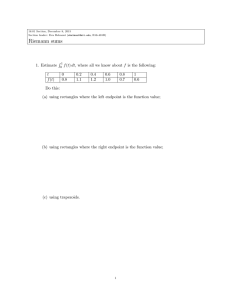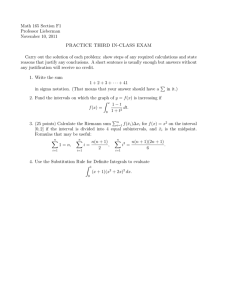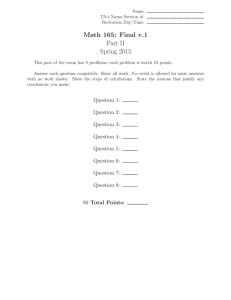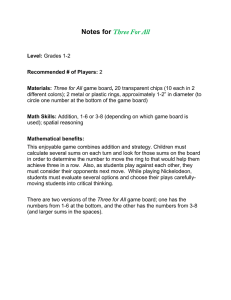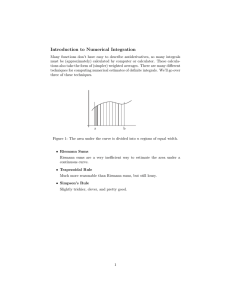Rearranging the Alternating Harmonic Series
advertisement
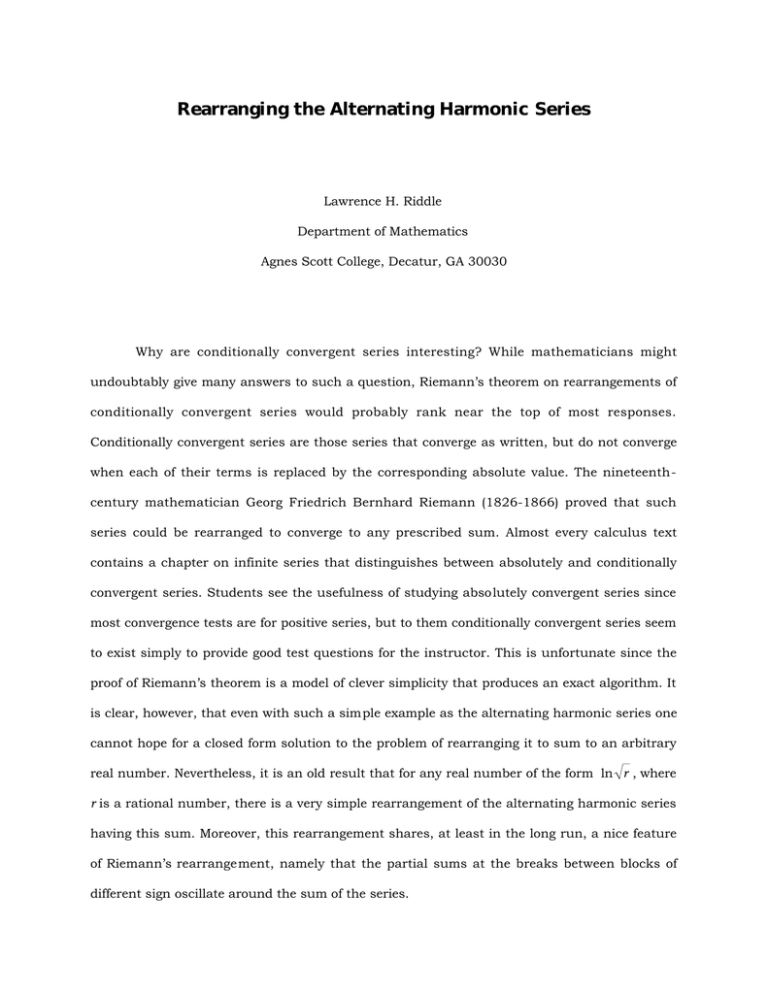
Rearranging the Alternating Harmonic Series Lawrence H. Riddle Department of Mathematics Agnes Scott College, Decatur, GA 30030 Why are conditionally convergent series interesting? While mathematicians might undoubtably give many answers to such a question, Riemann’s theorem on rearrangements of conditionally convergent series would probably rank near the top of most responses. Conditionally convergent series are those series that converge as written, but do not converge when each of their terms is replaced by the corresponding absolute value. The nineteenthcentury mathematician Georg Friedrich Bernhard Riemann (1826-1866) proved that such series could be rearranged to converge to any prescribed sum. Almost every calculus text contains a chapter on infinite series that distinguishes between absolutely and conditionally convergent series. Students see the usefulness of studying absolutely convergent series since most convergence tests are for positive series, but to them conditionally convergent series seem to exist simply to provide good test questions for the instructor. This is unfortunate since the proof of Riemann’s theorem is a model of clever simplicity that produces an exact algorithm. It is clear, however, that even with such a simple example as the alternating harmonic series one cannot hope for a closed form solution to the problem of rearranging it to sum to an arbitrary real number. Nevertheless, it is an old result that for any real number of the form ln r , where r is a rational number, there is a very simple rearrangement of the alternating harmonic series having this sum. Moreover, this rearrangement shares, at least in the long run, a nice feature of Riemann’s rearrangement, namely that the partial sums at the breaks between blocks of different sign oscillate around the sum of the series. 2 If we rearrange the alternating harmonic series so that instead of alternating 1 positive odd reciprocal with 1 even reciprocal, we alternate blocks of 375 consecutive odd reciprocals (the positive terms) with blocks of 203 consecutive even reciprocals (the negative terms), we will get a series that converges to 1 (well, almost) as depicted in Figure 1 (the vertical axis is not to scale in this figure). The turns in Figure 1 indicate the partial sums at the break between the positive and negative blocks. The partial sums seem to oscillate around 1. Now if we rearrange the series with blocks of 1 positive term followed by blocks of 36 negative terms, we will get a series that converges exactly to –ln(3). However, as we see from Figure 2, for this rearrangement the partial sums at the breaks require some initial posturing before they appear to start oscillating around the sum. 3.94522 1.00000 1.34535 1.20212 1.14344 -0.75395 -0.89707 -0.95579 S=1 0.99959 0.99970 -1.08728 0.99939 0.99877 S = -1.09861 -1.09707 -1.09865 -1.09906 Figure 1: p = 375, n = 203 Figure 2: p = 1, n = 36 How did we know to choose 375 and 203 in the first example, or 1 and 36 in the second? Why does the first example almost converge to 1, but the second converges exactly to -ln(3)? Why do these partial sums converge in the manner depicted in Figures 2 and 3? The purpose of this article is to address these issues by considering the following questions: 3 What is the sum of a “simple” rearrangement of the alternating harmonic series? How should the series be rearranged to obtain a sum within a given tolerance of a specified value? What is the behavior of the convergence of these simple rearrangements? The latter two questions are completely answered by Riemann’s theorem for rearrangements of arbitrary conditionally convergent series, but our goal is to provide a more concrete setting of Riemann’s results within the context of the alternating harmonic series with the hope that the reader will then have a better understanding of the general theory. As a bonus, we will encounter along the way some interesting mathematics in the form of Riemann sums, Euler’s constant, continued fractions, geometric sums, graphing via derivatives, and even Descarte’s Rule of Signs. The Sum of Simple Rearrangements The alternating harmonic series ∞ (−1)k +1 1 1 1 =1− + − + k 2 3 4 k =1 ∑ L is well known to have the sum ln 2. We will say that a series is a simple (p,n)-rearrangement of the alternating harmonic series, or just a simple rearrangement for short, if the first term is 1, the subsequence of positive terms and the subsequence of negative terms are in the original order, and the series consists of blocks of p positive terms followed by n negative terms; that is, the series has the form + 14442K444 3) (1 + 13 + 15 + p 1 2 p −1 + ) 1442K44 3 − ( 12 + 14 + n 1 2n + 1444K2444 3) + ( 2 p1+1 + 1 4 p −1 p + ) 1442K44 3 − ( 2n1+ 2 + n 1 4n + K (1) 4 For example, with p = 1 and n = 2 the series becomes K 1 1 1 1 1 1 1 1 1 1 1 − + − − + − − + − − + 2 4 3 6 8 5 10 12 7 14 16 1− K = 1 1 1 1 1 1 1 1 1 1 1 1− − − + − − + − + − − + 2 4 3 6 8 5 10 12 7 14 16 = 1 1 1 1 1 1 1 1 − + − + − + − + 2 4 6 8 10 12 14 16 = 1 1 1 1 1 1 1 1 1− + − + − + − + = 2 2 3 4 5 6 7 8 K K 1 ln 2 2 From this calculation, whose details can be easily justified, one readily sees that a different sum may be obtained by rearranging the original series. It is an old but apparently not well known result that a rearrangement of the form in p expression (1) has the sum ln 2 + 12 ln n . A brief history of this problem can be found in [5, p. 320]. After Riemann showed that by a suitable rearrangement of a conditionally convergent series, any prescribed behavior regarding convergence or divergence could be obtained, Ohm and Schlomilch investigated the rearrangements of the type given above, while Pringsheim [7] first discovered the general results for when the relative frequency of the positive and negative terms is modified to give a prescribed asymptotic limit. The reader is referred to [2, pp. 74-77] for additional details. For completeness, we include a derivation of the formula for simple rearrangements. ∞ Suppose ∑a k is a simple (p,n)-rearrangement of the form given in (1). For each positive k =1 integer m define Hm = 1 + K 1 1 1 + + + 2 3 m and E m = H m − ln(m +1) 5 1 x 1 2 3 4 5 m m+1 Figure 3 : H m and Em (shaded area) The term E m is the error of the Riemann sum H m illustrated in Figure 3 for approximating the definite integral ∫ m +1 1 1 dx . The sequence of error terms is a bounded increasing sequence of x positive numbers whose limit γ is called Euler’s constant. 1 By unraveling the rearrangement, we get that m ( p +n ) ∑ ak m = k =1 ∑ j =1 pj nj 1 1 − 2i i = p( j −1)+1 2i −1 i =n ( j −1)+1 2mp −1 = ∑ i =1 ∑ 1 − i ∑ 1 2 mp −1 ∑ i =1 1 − i 1 2 mn ∑i 1 i =1 = H 2mp −1 − 12 H mp −1 − 12 H mn = ln(2mp ) − 12 ln(mp ) − 12 ln(mn +1) + E 2mp −1 − 12 E mp −1 − 12 E mn = ln(2) + 12 ln mp + E 2mp −1 − 12 E mp −1 − 12 E mn . mn +1 Now let m go to infinity to obtain 1 γ = 0.5772156... It is not known whether γ is rational or irrational, but by using continued fractions Brent [1] has shown that if γ is rational, then it’s denominator must exceed 1010000 . 6 m ( p +n ) lim m →∞ ∑a k =1 p k = ln 2 + 12 ln n + γ − 12 γ − 12 γ p = ln 2 + 12 ln n . (2) Of course, this only considers those partial sums with a full complement of p+n terms; because the terms approach 0, however, this is sufficient to give the sum of the series. How to Choose p and n Formula (2) shows that only real numbers of the form ln r , where r is a rational number, can be obtained exactly as the sum of a simple rearrangement. In this case we need only choose p and n to satisfy p/n = r/4. For example, a simple (1,4)-rearrangement will have the sum 0 = ln(1). More generally, for a positive integer m, an (m 2,4)-rearrangement will sum to ln(m) while a (1,4 m2)-rearrangement will have sum –ln(m ). So how do we get a rearrangement that sums to –ln(3)? Take p = 1 and n = 36. What if we want our rearrangement to sum to a value S? Unless S is of the form ln r we cannot do this exactly, but suppose we are willing to get within ε of S. Now how should we p choose p and n? By solving ln 2 + 12 ln n = S, we see that we need p/n to be approximately equal to e 2S /4 . In order to analyze the situation more carefully, we would like to find a δ > 0 such that if the integers p and n satisfy e 2S p e 2S 1 p −δ < < + δ, then S − ln 2 + ln < ε . This leads 4 n 4 2 n to the following chain of inequalities 1 1 e 2S p 1 e 2S ln − δ < ln < ln + δ 2 4 2 n 2 4 ⇒ 1 e 2S 4δ 1 p 1 e 2S 4δ ln 1 − 2S < ln < ln 1 + 2S 2 4 e 2 n 2 4 e ⇒ 1 e 2S 1 4δ 1 p 1 e 2S 1 4δ ln + ln 1 − 2S < ln < ln + ln 1 + 2S 2 4 4 2 2 e 2 n 2 e 7 Now two inequalities about logs come to our assistance. They are that for positive values of x −x . Both of these inequalities can be verified 1− x 4δ using the “racetrack principle.”2 Applying them with x = 2S shows us that e less than 1, we have ln(1 + x ) < x and ln(1 − x ) > 4δ 2S 1 p 1 4δ 1 e < ln < S − ln 2 + S − ln 2 − 2 1 − 4δ 2S 2 n 2 e 2S e and so 1 1 p 2δ 2δ S − ln 2 + ln < max 2S , 2S 4δ 2 n e 1− e e 2S To have our sum with ε of S, therefore, we should pick δ so that 2δ = 2S e − 4δ 2δ e 2S ε = ε . So take δ = 2 + 4ε e − 4δ 2S and then choose p and n so that the ratio p/n is within δ of e 2S / 4 . There still remains one problem, however. There are an infinite number of choices for p and n for which p/n lies in the interval of width 2 δ around e 2S /4 . Which is the best choice to make? In the spirit of Riemann’s proof, let us say that an irreducible fraction r/s is simpler than the fraction e/f if 0 < r ≤ e and 0 < s ≤ f. Then we want to find the simplest fraction in the interval; that is, the one with the smallest numerator and denominator. Let G = e 2S /4 and let δ be as chosen above. If the interval (G–δ, G+δ) contains an integer then letting p be the smallest integer in the interval and n = 1 will give the simplest rational that we are looking for. If this is not the case, then the theory of continued fractions provides the tools for efficiently finding the simplest fraction. A finite simple continued fraction is an expression of the form 2 Ok, it’s really the Mean Value Theorem. If two horses start at the same spot and one always runs faster than the other, then it will always stay ahead. 8 a1 + 1 a2 + 1 a3 + 1 a4 + O+ 1 a n −1 + 1 an where the first term a1 is usually a positive or negative integer (or zero) and where the terms K a 2 , a 3 , , a n are positive integers called the partial quotients. A much more convenient way to write this expression is as [a1, a 2 , a 3 , K, a n ] . Every rational number can be expanded in the form of a simple finite continued fraction. Every irrational number can also be expanded in the form of a simple continued fraction, but one that requires an infinite number of partial quotients a i . We would like to find a finite continued fraction that approximates the irrational number G = e 2S / 4 (if this number were rational, the desired sum S could be obtained exactly as discussed in the first paragraph of this section.) The following algorithm will generate the continued fraction approximations to G [6]. First, define x 1 = G and then recursively define a k = x k (where y denotes the floor function, that is, the greatest integer less than or equal to y) and x k +1 = 1/ (x k − a k ), The terms K K are the partial quotients of the continued fraction. Next, let a 1 ,a 2 , ,a k , p 0 = 1, q 0 = 0 , p1 = G , and q1 = 1. Now we recursively define the convergents pk / qk by pk = a k pk −1 + pk −2 qk = a k qk −1 + qk −2 Then pk / qk = [a1, a 2 , a 3 , K, a k ] and these rational numbers converge to G . Stop the construction the first time that G − pk +1 < δ. The number pk +1 / qk +1 will then be the closest qk +1 rational number to G with denominator no larger than qk +1 but there may still be a simpler rational number in the interval (G–δ, G+δ). To find it let θ = G − δsign(pk / qk − G ) and let 9 p − θqk +1 j = k +1 pk − θqk Finally, set p = pk +1 − jpk and n = qk +1 − jqk . We claim that p/n is now the simplest rational in (G–δ, G+δ). The continued fraction approximations of an irrational satisfy the following two properties that will be useful to us: (i) (ii) p1 p 3 < < q1 q 3 L < G < L < qp 4 4 < p2 q2 pi +1qi − pi qi +1 = (−1)i +1 for each i. Proofs of these can be found in any book on continued fractions such as [4] or [6]. We will also need the simple but useful result that if b, d and y are positive integers with a x c < < b y d and bc – ad = 1, then y > d and y > b. This follows because ay < bx and dx < cy give y = (bc − ad )y > (bx − ay)d ≥ d and y = (bc − ad )y > (cy − dx )b ≥ b Let us now return to our proof that p/n is the simplest rational in (G–δ, G+δ). We will treat the case when p pk +1 <G < k qk +1 qk (3) 10 and leave the other case to the reader. Inequality (3) and property (i) implies that k is even and therefore that pk qk +1 − pk +1qk = 1. (4) Moreover, θ = G – δ. Equation (4) and the choice of j ensure that G −δ < pk +1 − jpk pk +1 ≤ <G +δ qk +1 − j qk qk +1 (5) and therefore that p/n does lie in the desired interval. One should also note that j is the largest integer for which the left most inequality in equation (5) holds, with one exception. It is possible that in the computation of j, the term (pk +1 − θqk +1 )/ (pk − θqk ) will already be an integer (this will happen only if G–δ is rational), in which case we must adjust j. To show that p/n is the simplest fraction in this interval, observe that any other fraction x/y in (G–δ, G+δ) must satisfy either pk +1 − ( j +1)pk x p < < qk +1 − ( j +1)qk y n or p x pk < < n y qk But it is easy to check using equation (4) that (qk +1 − ( j +1)qk )p − (pk +1 − ( j +1)pk )n = 1 and npk − pqk = 1, so by our earlier remark we must have y > n, which completes the proof. Table 1 gives appropriate values for p and n for several choices of S and ε . In the appendix we list a program to compute p and n on an HP-28S calculator. Remember, however, that the actual value that needs to be approximated by p/n is not S, but G = e 2S /4 which grows rapidly as S is increased. Nevertheless, the continued fraction algorithm is quite fast. One reason for this is that δ also grows as S is increased. Indeed, if S > 1 2 log ( 2ε + 4 ) then we 11 would have δ > 1 so that the algorithm would stop immediately with p equal to the smallest integer in the interval and n = 1. For example, when ε = .00001 this would happen whenever S exceeds 6.10305. Table 1: Values of p and n for which the rearranged series sums to within ε of S. Desired Sum S 0.4 1 1 π π π 5 10 −1 −2 −π −10 epsilon 0.00001 0.00005 0.00001 0.1 0.001 0.0001 0.00001 0.00001 0.00001 0.0000001 0.0001 0.00005 p 74 133 375 112 134 937 16,520 121,288,874 97 135 1 1 n Error 133 72 203 1 1 7 3 1 2,867 29,483 2142 1,940,466,75 5 0.00000516 0.00001131 0.00000720 0.08919604 0.00047442 0.00005891 0.00000456 0.00000999 0.00000806 0.00000002 0.00000779 0.00004999 The Behavior of the Convergence of Simple Rearrangements Riemann’s algorithm for rearranging a conditionally convergent series is really quite simple. One starts by adding positive terms until you just exceed the desired sum, then you start subtracting the negative terms until you just drop below the sum, and continue alternating in this fashion. The trouble, of course, is that it is impossible to know in advance how many terms will be necessary at each step. Nevertheless, the end result is a rearrangement in which the partial sums at the break between blocks of different signs oscillate around the sum of the series. What behavior do the partial sums of a simple rearrangement exhibit? Because we will be interested in the blocks of positive and negative terms. let us define pk R 2k −1 = ∑ 1 2 j −1 j = p(k −1)+1 nk and R 2k = ∑ 1 2j j =n (k −1)+1 12 so R 2k −1 is the kth block of positive terms and R 2k is the kth block of negative terms. We want ∞ to investigate the behavior of the partial sums of the series ∑ (−1) i +1 Ri . Look back at Figures 1 i =1 and 2 to see the first 8 partial sums for a (375,203)-rearrangement and a (1,36)-rearrangement respectively. In Figure 1 we see that the partial sums oscillate around the limit S = 1, while in Figure 2 it appears that it takes some initial posturing before the partial sums start to oscillate around S = –ln(3). Moreover, the first eight Ri ’s in Figure 1 are strictly decreasing as one can readily check. To analyze the behavior of the partial sums, let us fix values of p and n and consider the difference R 2k −1 − R 2k . Because it is difficult to work with arithmetic sums, we first convert the problem to one involving a polynomial function. This will allow us to use many of the tools of calculus. Towards this end, define the polynomial Qk (x ) by pk Qk (x ) = x (2 j −1)n 2 j −1 j = p(k −1)+1 ∑ nk − x 2 jp 2j j =n (k −1)+1 ∑ and note that Qk (1) = R 2k −1 − R 2k . Our first goal, then, is to find when Qk (1) > 0 . The derivative of the polynomial Qk (x ) is given by pk Qk′ (x ) = n ∑ x (2 j −1)n −1 j = p(k −1)+1 nk − p ∑x 2 jp −1 j =n (k −1)+1 Notice that the derivative is 0 at both x = 0 and x = 1. For x ≠ 0 and x ≠ 1 we can make use of the observation that we have two finite geometric sums to write the derivative in closed form as Qk′ (x ) = x 2 pn (k −1)+n −1 (1 − x 2 pn ) g(x ) (1 − x 2 p )(1 − x 2n ) 13 where g(x ) = n − x 2 p −n (p + nx n − px 2n ) . The exponent 2p–n suggests that we will need to consider 3 cases to determine the behavior of Qk′ (x ) . Case 1: 2p = n. In this case we have g(x ) = p − 2px n + px 2n = p(x n − 1)2 and thus g(x) > 0 for 0 < x < 1. This in turn implies that Qk′ (x ) > 0 for 0 < x < 1. Since Qk (0) = 0 and since the function is increasing on the interval (0,1), we must have Qk (1) > 0 for all k. Case 2: 2p > n. Here we have g ′(x ) = −x 2 p −n −1h(x ) where h(x ) = 2p 2 − pn + 2pnx n − (2p 2 + pn )x 2n = p(2p + n )(1 − x n )(x n + 2p − n ) 2p + n (6) From this we see that h(x) > 0 on the interval (0,1) and that therefore g ′(x ) < 0 on the interval (0,1). Thus g(x) is decreasing on this interval and so g(x ) > g(1) = 0 for 0 < x < 1. As in case 1, this implies that Qk (1) > 0 for all k. Case 3: 2p < n. This is the interesting case. Here g(x ) = n − p + nx n − px 2n x n −2 p and so Qk (x ) is negative on an interval to the right of 0. Will it recover to become positive at x = 1? Notice first that g(x) has the properties (i) (ii) lim g(x ) = −∞ ; x →o + lim g(x ) = +∞ x →∞ (iii) g(1) = 0; (iv) n − 2p g(x) has a local minimum at x = 1 and a local maximum at x o = n + 2p 1/n ∈(0,1). To see why (iv) is true, take another look at h( x) in equation (6). These four conditions tell us that the graph of g(x) must look something like that depicted in Figure 4, which in turn implies 14 x̃ x̃ xo 1 1 Figure 5: Qk′ (x ) for 2p < n Figure 4: g(x) for 2 p < n x̃ x̃ 1 x̃ 1 1 (a) (b) (c) Figure 6: The three possibilities for Qk (x ) when 2p < n that the graph of Qk′ (x ) has the form shown in Figure 5, where the point x̃ satisfies Qk′ ( x̃ ) = g( x̃ ) = 0 . There are thus three possibilities for the graph of Qk (x ) , which are illustrated in Figure 6. We would like to know when the graph has the form of Figure 6(c). To investigate this, let us rewrite each of the sums in the polynomial for Qk (x ) in terms of the new index i = j – p(k – 1) for the first sum and i = j – n(k – 1) for the second sum, and then multiply by 2pnkx −2 pn (k −1) . This gives a new polynomial Q̂k (x ) = 2pnkx −2 pn (k −1)Qk (x ) p = ∑ i =1 2pnk x (2i −1)n 2i + 2pk − 2p − 1 n − ∑ 2i + 2nk − 2n x 2pnk 2ip i =1 which has the property that Qk (x ) is positive if and only if Q̂k (x ) is positive. Moreover, p lim Q̂k (x ) = n k →∞ ∑ x (2i −1)n n − i =1 p ∑x 2ip = L(x ) i =1 where this convergence is uniform on the interval [0,2]. But L(1) = 0 and p L ′(1) = n 2 ∑ i =1 n (2i −1) − p2 ∑ 2i i =1 = − p 2n 15 L (x ) 1 band of width 2 Figure 7: The uniform convergence of Q̂k (x ) to L(x ) so that we can find an interval centered at 1 and a band of width 2ε as depicted in Figure 7 such that for some positive integer k o the values of Q̂k (x ) lie in the band for all k > k o and for all x in the interval centered at 1. This implies that for all k > k o the function Q̂k (x ) , and hence also Qk (x ) , must take positive values near 1. In particular, the only possibility when k is greater than k o is that the graph of Qk (x ) must be as in figure 6(c). Thus Qk (1) > 0 for all k > ko . It is time for a recap. We have now shown that if 2p ≥ n then R 2k −1 > R 2k for all k, while if 2p < n, then R 2k −1 > R 2k for all k > k o where k o depends on p and n. Now what about R 2k − R 2k +1 ? To answer this, let us proceed as before and define a polynomial Wk (x ) by p(k +1) nk x 2 jp Wk (x ) = 2j j =n (k −1)+1 ∑ − x (2 j −1)n 2 j −1 j = pk +1 ∑ It is easy to check that Wk (0) = 0 , Wk (1) = R 2k − R 2k +1, and Wk′ (1) = pn − np = 0 . This polynomial has another interesting property, however. If we check the relative sizes of the powers of x in Wk (x ) we see that the largest power of the positive terms is 2pnk while the smallest power of the negative terms is 2pnk+n. Therefore all the positive coefficients occur before all the negative coefficients when the terms of Wk (x ) are written in order of increasing exponent. Moreover, the same must be true of the coefficients in Wk′ (x ). Thus Descarte’s Rule of Signs [3] tells us that 16 Wk′ (x ) has exactly one positive root since its coefficients have exactly one variation in sign. The only positive root of Wk′ (x ), 1 therefore, is at x = 1. Since lim Wk (x ) = −∞ the graph of Wk (x ) must x →∞ behave as illustrated in Figure 8, from which we see that Figure 8: Wk (x ) Wk (1) = R 2k − R 2k +1 > 0 for all k. So now we know the complete story about what is happening in Figures 1 and 2. Whenever 2p > n, as in Figure 1, we have that Ri > Ri +1 for all integers i, but if 2p < n, as in Figure 2, then Ri > Ri +1 once i is sufficiently large, with the exact value depending on the values of p and n. Thus, in the long run, the partial sums of a simple rearrangement of the alternating harmonic series do oscillate at the breaks between blocks of different sign around the sum of the series. The generality we have lost from Riemann’s Theorem by requiring fixed block sizes of positive and negative terms has been offset by the knowledge of how the rearrangement must be made, while essentially maintaining the oscillatory behavior of the convergence. 17 References 1. R. P. Brent, Computation of the regular continued fraction for Euler’s constant, Mathematics of Computation 31 (1977) 771-777. 2. T. Bromwich, An Introduction to the Theory of Infinite Series (2nd ed.), Macmillan, London, 1947. 3. F. Cajori, An Introduction to the Theory of Equations, Dover Publications, Inc. 4. G. H. Hardy and E. M. Wright, An Introduction to the Theory of Numbers (4th ed), Oxford University Press, London, 1975. 5. K. Knopp, Theory and Application of Infinite Series , Hafner Publishing Co., NY, 1971. 6. C. D. Olds, Continued Fractions, Random House New Mathematical Library (vol 9) 1963. 7. A. Pringsheim, Über die Werthversänderunge bedingt convergierten Reihe und Producte, Mathematische Annalen 22 (1883) 455-503. 18 Appendix We give here two programs for the HP-28S for finding the simplest rational in a given interval (SRAT) and for computing the p and n to obtain a sum S within an error ε (AHS). We will assume for the program SRAT that the interval is on the positive real axis since that is all that is needed for AHS. SRAT (Simplest Rational) For arguments x and δ, SRAT returns the simplest rational p/n in the interval [x–δ, x+δ] Arguments 2: 1: x δ Program: << →xe << RCLF 0 FIX IF x DUP FLOOR – e < THEN x e – FLOOR 1 + 1 ELSE (1,0) x FLOOR 1 R→C x DUP FLOOR WHILE 3 DUPN DROP2 C→R / x – ABS e ≥ REPEAT – INV DUP FLOOR DUP 4 ROLL DUP 6 ROLLD * 4 ROLL + 3 ROLLD END DROP2 C→R 3 ROLL C →R → p1 q1 p0 q0 << p0 q0 / x – SIGN e * x SWAP – DUP q1 * p1 – SWAP q0 * p0 – / FLOOR DUP p0 * p1 SWAP – SWAP q0 * q1 SWAP – >> END 'P/N' 3 3 ROLL 1 →LIST OBSUB 1 3 ROLL 1 →LIST OBSUB SWAP STOF >> >> Results 1: 'p/n' Comments: Recall the user flags; set Fix display to 0 Check if x is in the interval. If so ... compute the smallest integer in the interval If not ... initialize continued fraction algorithm Repeat until there is a convergent in the interval ... Compute next convergent and partial quotient p1/q1 is the last convergent computed, p0/q0 is the previous one. Use these to compute θ, j, p, and n Substitute n for N in 'P/N', then substitute p for P Restore the user flags to their original settings 19 RAHS (Rearranged Alternating Harmonic Series) For arguments S and ε, RAHS returns the smallest block sizes p and n such that a (p,n) rearrangement of the alternating harmonic series will sum to within ε of S. 2: 1: Arguments desired sum S error tolerance ε Program: << SWAP 2 * EXP DUP 4 / 3 ROLLD OVER * SWAP 4 * 2 + / SRAT DUP →NUM LN 2 / 2 LN + >> 2: 1: Results 'p/n' actual series sum Comments: Convert S to e 2S / 4 and ε to δ = e 2S ε / (2 + 4ε) Call the SRAT program Compute the sum of the rearranged series
